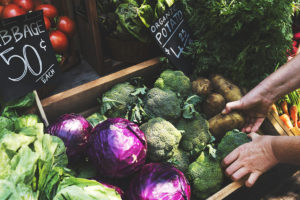
Household goods costs are rising and food isn’t getting cheaper. That’s the outlook in American homes this year.
Amid a tight budget and high prices, what steps can you take to ensure you and your family eat healthy, great-tasting food?
Planning is the name of the game, Spectrum Health registered dietitian Kristi Veltkamp said.
“Lack of planning is the biggest deal-breaker,” Veltkamp said.
Does your daily routine involve the question, “What’s for dinner?” Do you rummage through the refrigerator or pantry at the last minute, hoping to whip up something suitable for dinner?
It may be time to sit down and think carefully about how you’re spending your food money. It can help you avoid the desperate, late-evening runs to fast-food restaurants or pizza parlors—or pricey restaurants—and it’ll keep your wallet and your waistline in top shape.
Veltkamp’s 5 tips to keep your food budget under control:
1. Plan your meals
This is the No. 1 solution to save money. Planning your meals ahead of time allows you to build according to your budget. It sets you up for success each week, Veltkamp said.
It’s not just about dinner, either. “You can pack your lunch so you don’t have to go out at work,” Veltkamp said. “And you can plan to use the leftovers.”
You should also aim for more vegetarian meals—they’re cheaper and healthier. “Meat tends to be the most expensive item,” Veltkamp said.
With a creative mind, you can find new and innovative ways to use items such as beans and rice, which are cheaper and preserve longer, she said. Tacos made from rotisserie chicken and all the fixings, for example, make for a quick, cheap and easy meal.
2. Get Crocking
If you plan your meals ahead at the start of each week, the Crock-Pot can prove to be a lifesaver not only in money but in time, too.
“When you’re doing the cooking yourself, you’ll save more money,” Veltkamp said.
The tacit message here: Stay away from restaurants as much as possible—they eat up your budget. (They also increase your salt intake.)
Generally, Crock-Pot meals can be healthy. “It depends on what you’re putting into it,” Veltkamp said. Canned goods are OK, but you should rinse them first to cut down on the sodium.
“One of the ways it saves on money is when you use more ingredients that haven’t been prepared—raw products like rice, potatoes, beans or even frozen veggies,” Veltkamp said.
3. Buy in season
Items that are local, fresh and in season should be on your list each week.
“They’re higher in nutrients and they haven’t been delivered across the globe,” Veltkamp said. “And if you buy a lot at once, they’re cheap. You can can them or freeze them and save them for later.”
This includes berries, greens, tomatoes and much more. Veltkamp said some people will toss their herbs in water and freeze them into cubes, then throw them into soups once they’re needed.
One tip: Buy in-season items fresh, then buy them mostly canned or frozen when they’re out of season. Some fresh produce can get pricey when it’s out of season.
4. Buy in bulk
Bulk food stores are sometimes hard to come by without a membership—Costco, Sams Club and the like.
But if you can manage to pick up some essential items in bulk, you can truly save a bundle.
What should you buy in bulk? “Things that aren’t going to spoil fast,” Veltkamp said. “Nuts, grains, rice, beans, flour—non-perishable items.”
5. Shun the junk
This is a big one. Junk foods may sometimes appear like the cheap way to go, but in the long run you’re only setting yourself up for trouble.
Junk foods—processed foods, sugary foods—offer empty calories that only leave you craving more.
“Your body doesn’t need the empty calories,” Veltkamp said. “If you eat healthy, you crave less.”
Healthy foods are simply more filling.
Think about it: A bag of chips is a few bucks, but there are many people who can sit down and make that bag disappear in one evening. A bag of apples may cost slightly more.
“But who sits down and eats a bag of apples?” Veltkamp said. One or two apples will satisfy hunger cravings and also deliver much-needed nutrition.
“Healthier foods tend to fill you up more and make you more satisfied,” Veltkamp said. “You don’t have the cravings you get with those processed foods.”
Bottom line: You’re eating less food and getting more nutrition.
 /a>
/a>
 /a>
/a>
 /a>
/a>